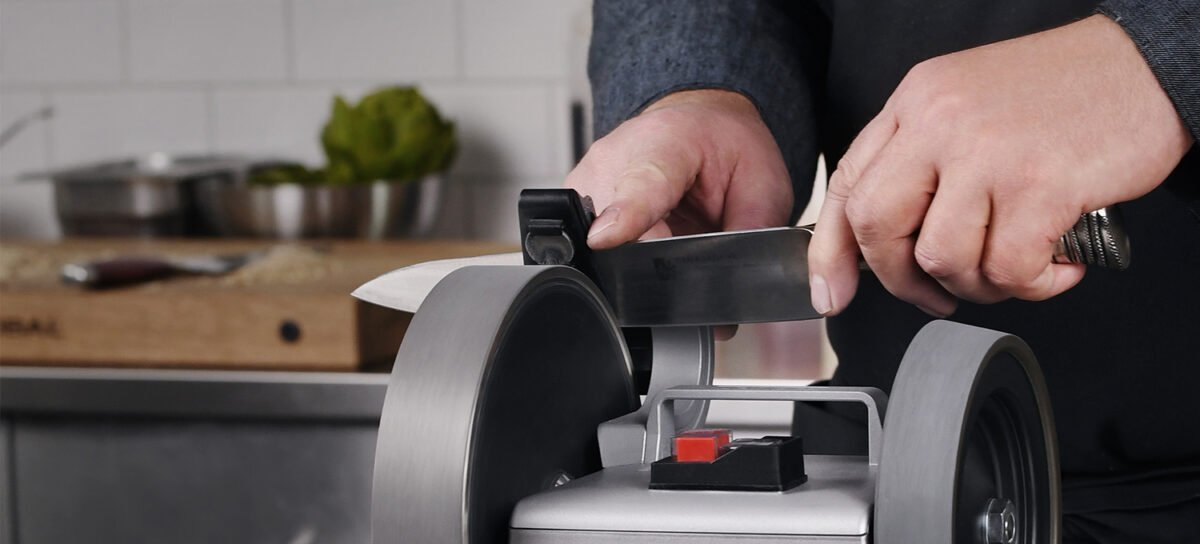
In any professional or home kitchen, a sharp knife is not just a matter of convenience – it’s a matter of safety, efficiency and quality in food. However, what many people overlook is that a sharp edge depends not only on sharpening, but also on the right sharpening angle.
The science behind sharpening angles
The angle at which a knife is sharpened determines the shape of its edge and directly affects both sharpness and durability:
- Angles 10-17° per side: Very sharp edge, ideal for thin cuts (e.g. sushi knives), but more delicate and wears out quickly.
- 18-20° angles: a balance between sharpness and durability – ideal for European-style knives.
- 21-25°+ angles: more strength, suitable for tough applications such as chopping hard vegetables or bones.
If the sharpening angle is not correct, the knife may look dull or lose its edge quickly.
The difficulty of the fixed angle by hand
Achieving a consistent sharpening angle by hand is extremely difficult without experience. Even small deviations can lead to uneven cuts and reduced performance. Many cooks sharpen with the “eye” or in inaccurate ways – resulting in unstable results and excessive metal wear.
That’s why the guided sharpening system is so useful.
The smart solution: the Tormek T-2 with adjustable angle guide
The Tormek T-2 Pro Kitchen Knife Sharpener is designed for professional kitchens that require precision and speed. It stands out for its adjustable angle guide, which allows you to choose the exact angle depending on the type of knife.
This means you can easily adjust the angle to 15° for a Japanese knife or 20° for a classic chef’s knife, ensuring a consistent and predictable result every time. The system includes a diamond and composite wheel for excellent results with minimal metal wear.
How to find the right angle: The Tormek marker method
Don’t know at what angle your knife has been sharpened from the factory? Use Tormek’s marker method:
- Colour the edge of the knife with a marker.
- Place the knife on the guide and adjust the angle so that the entire blade rests on the wheel.
- With the machine switched off, manually turn the wheel and check where the marker was removed.
- Adjust the angle slightly and repeat until the ink is removed evenly across the edge.
When the ink has run off evenly, you have found the right angle. You are ready for sharpening.
Sharpening angles guide from manufacturers
Manufacturers often recommend specific angles for their knives. If you can’t find the information on the packaging, you can find it on their website. See below for indicative prices:
| Manufacturer | Recommended Angle |
|---|---|
| Cangshan | 16° |
| Chroma | 10-20° |
| F. DICK | 15-20° |
| Fischer-Bargoin | 15-20° |
| Global | 10-15° |
| Korin (western type) | 10-20° |
| MAC | 10-15° (factory setting: 15°) |
| Knife master | 15° |
| Shun & Kai | 16° |
| Victorinox | 15-20° per side (30-40° total) |
| Wüsthof | 14° (typical), 10° (Asian) |
| Twin / Miyabi | 15°, 9-12° for Santoku & Miyabi |
Notes: Most corners are reported as single hollowed out (one side). For example, a knife with “15°” means 15° per side or 30° total.
Designed for the Real Kitchen
The Tormek T-2 is not just a sharpener – it’s a tool that saves time, reduces wear and tear and delivers consistent results. Its precise angle adjustment and simple operation make it ideal for kitchens with high demands.
Conclusion: It’s not enough to have a sharp knife – you have to keep it that way. And it all starts with the right sharpening angle.
